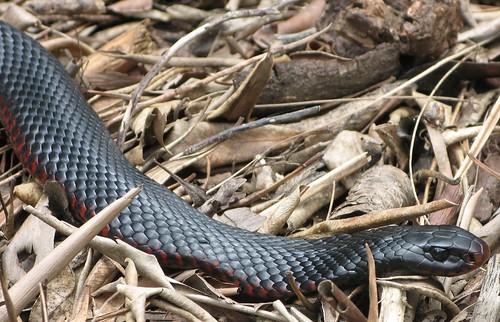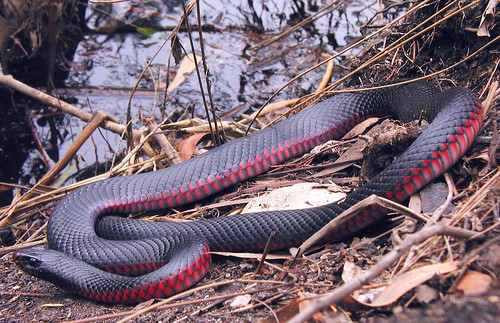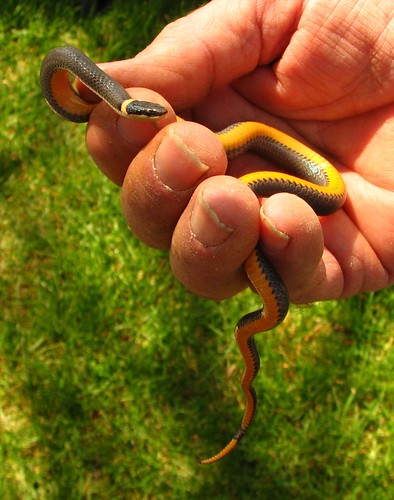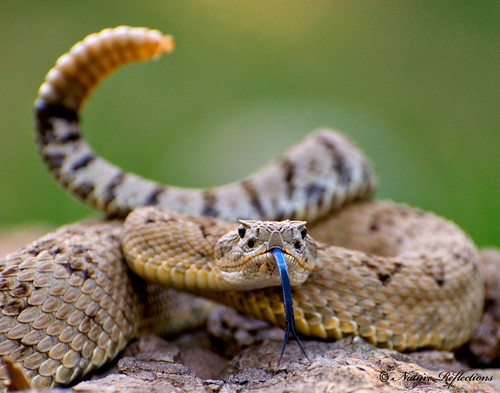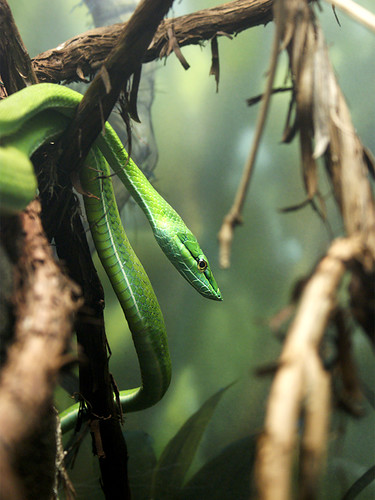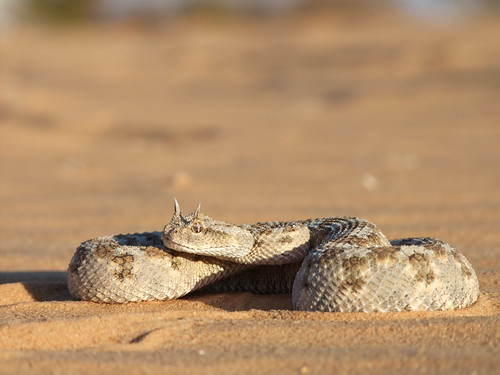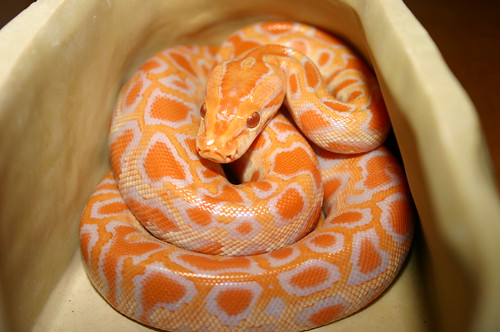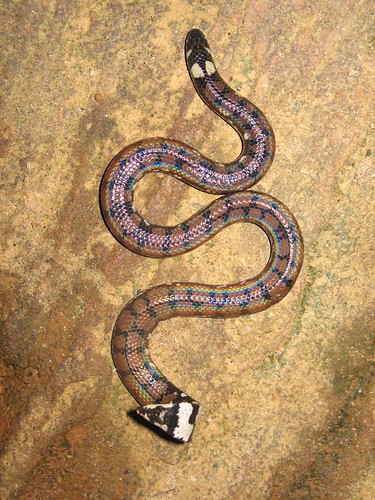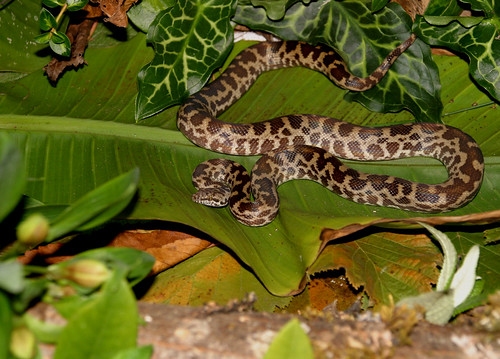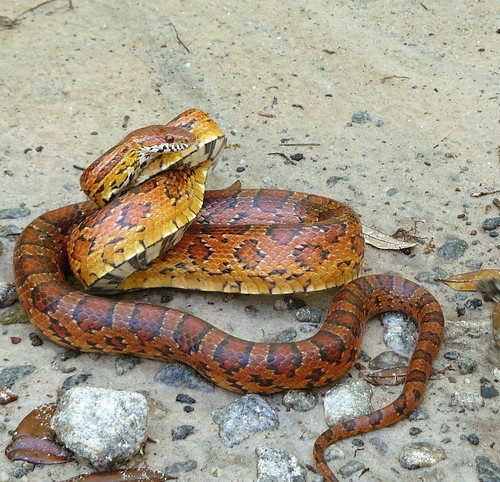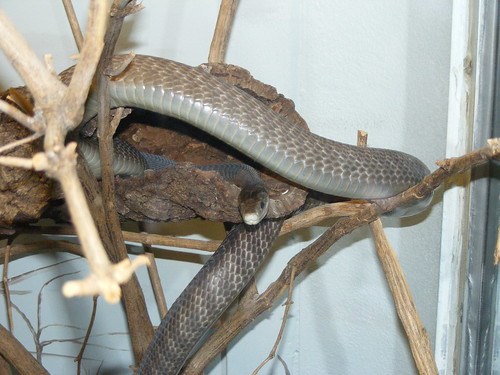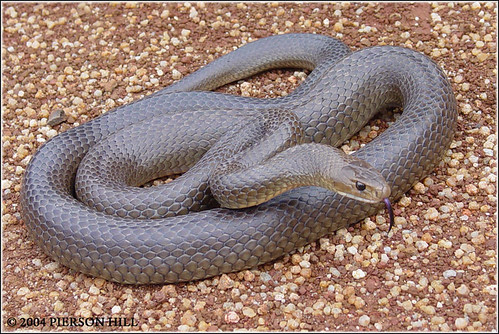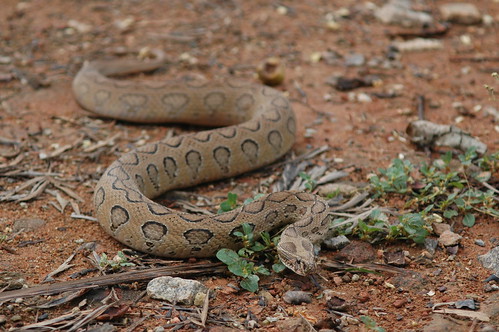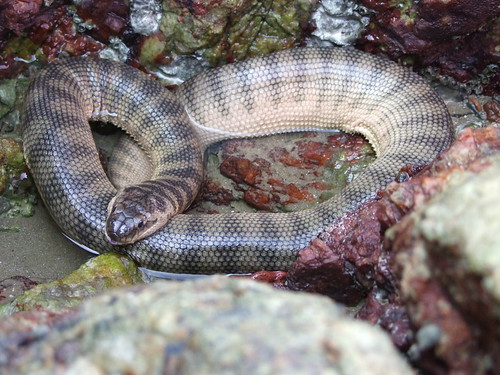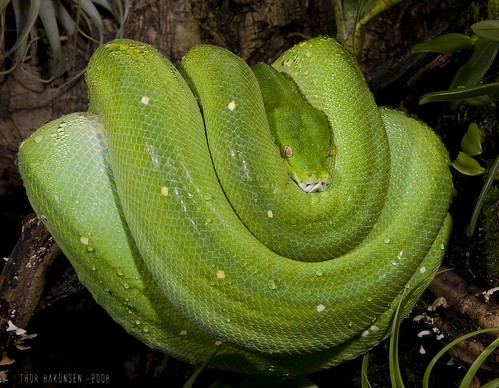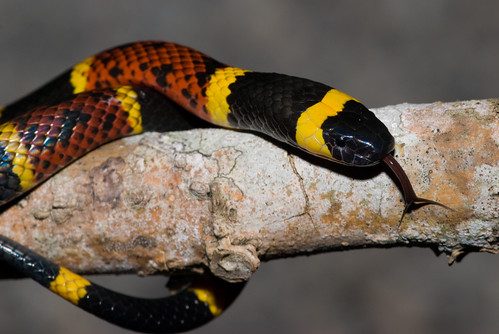
Custom Search
Tuesday, June 30, 2009
Berg Adder
Bitis atropos the common names is Berg Adder is a venomous viper species found only in three mountainous regions in southern Africa. A small species that is unusual in that its venom includes a major neurotoxin. No subspecies are currently recognized.
The average adult size is 30-40 cm, with some females reaching a maximum 50 cm in the wild and 60 cm in captivity.
Sunday, June 28, 2009
Red-bellied Black Snake
The Red-bellied Black Snake, Pseudechis porphyriacus, is a venomous species of elapid snake native to eastern Australia. Though its venom is capable of causing significant morbidity, it is not generally fatal and less venomous than other deadly Australian snakes. It is common in woodlands, forests and swamplands of eastern Australia. It is one of Australia's best known snakes, as it is common in urban areas along the eastern coast of Australia.
The Red-bellied is glossy black on the dorsal surface and a brilliant red or crimson colour on the ventral surface. The snout is often a lighter brown colour. It is a relatively large species of snake reaching about 1.5m to 2.5m. Like all elapid snakes it is front fanged. It has 17 mid-body scale rows. It looks similar to the Eastern Small-eyed Snake.
Friday, June 26, 2009
Ring-Necked Snake
The Ringneck Snake (Diadophis punctatus) is a species of colubrid snake which is harmless to humans. There is some evidence that oral secretions produced by at least some subspecies, such as D. p. occidentalis are highly toxic to their prey. An enlarged tooth at the back of the mouth is thought to play a role on the envenomation of prey. It is the only species within the genus Diadophis, and has fourteen subspecies which are found from southeastern Canada, throughout much of the United States, to northern Mexico.
Ringneck snakes are members of the colubrid family. They are typically black or gray in color, with a yellow or orange underside and an orange or yellow ring around the neck. The underside usually has black flecks or dots in many different patterns, depending on the subspecies. They are very common and are found throughout North America and northern Mexico. They tend to grow to 10-14 in. and are long and slender. They make their homes under rotting logs, wood, and rocks. These snakes eat insects, frogs and salamanders, other snakes, lizards, and newborn rodents.
Thursday, June 25, 2009
Great Basin rattlesnake
Crotalus oreganus lutosus is a venomous pitviper subspecies found in the Great Basin region of the United States.
Adult specimens are 66-121 cm in length, but rarely exceed an overall length of 1 m. The males grow larger than the females.
On the subject of scalation, one of the more distinctive characteristics of this subspecies is that it has three or more internasal scales -- something that it has in common with C. viridis.
The color pattern usually consists of a buff, pale gray, pale brown, olive brown or yellowish brown ground color, overlaid with a series of 32-49 dorsal blotches. These blotches are dark brown to black in color, with pale centers and pale borders, and are often irregular in shape and wider than they are long. There is also a series of lateral blotches that are indistinct anteriorly, but become more distinct posteriorly and eventually merge with the dorsal blotches to form crossbands. Older specimens either have sometimes have a faded pattern, or they may have uniformly black blotches, with the dorsum of the head also being black.
Adult specimens are 66-121 cm in length, but rarely exceed an overall length of 1 m. The males grow larger than the females.
On the subject of scalation, one of the more distinctive characteristics of this subspecies is that it has three or more internasal scales -- something that it has in common with C. viridis.
The color pattern usually consists of a buff, pale gray, pale brown, olive brown or yellowish brown ground color, overlaid with a series of 32-49 dorsal blotches. These blotches are dark brown to black in color, with pale centers and pale borders, and are often irregular in shape and wider than they are long. There is also a series of lateral blotches that are indistinct anteriorly, but become more distinct posteriorly and eventually merge with the dorsal blotches to form crossbands. Older specimens either have sometimes have a faded pattern, or they may have uniformly black blotches, with the dorsum of the head also being black.
Wednesday, June 24, 2009
Green vine snake
The Green vine snake (Ahaetulla nasuta), is a slender green tree snake found in India, Sri Lanka, Bangladesh, Myanmar, Thailand, Cambodia and Vietnam.
The green vine snake is diurnal and mildly venomous. The reptile normally feeds on frogs and lizards using its binocular vision to hunt. They are slow moving, relying on camouflaging as a vine in foliage. The snake expands its body when disturbed to show a black and white scale marking. Also, they may open their mouth in threat display and point their head in the direction of the perceived threat. There is a widespread myth in parts of southern India, that the species uses its pointed head to blind its human victims.
The species is viviparous, giving birth to young that grow within the body of the mother, enclosed within the egg membrane. They may be capable of delayed fertilization as a female in the London zoo kept in isolation from August, 1885 gave birth in August, 1888. The venom is mild and causes swelling. Symptoms will subside within three days.
The species is viviparous, giving birth to young that grow within the body of the mother, enclosed within the egg membrane. They may be capable of delayed fertilization as a female in the London zoo kept in isolation from August, 1885 gave birth in August, 1888. The venom is mild and causes swelling. Symptoms will subside within three days.
Tuesday, June 23, 2009
Horned Viper
Cerastes is a genus of small, venomous vipers found in the deserts and semi-deserts of northern North Africa eastward through Arabia and Iran. Three species are currently recognized.
Cerastes are small snakes, averaging less than 50 cm in length, but are relatively stout in appearance. The head is broad, flat and distinct from the neck. The head is covered with tubercularly keeled scales, which usually number 15 or more across, and a supraorbital horn may be present over each eye in some species. The snout is short and wide and the eyes, which are set well forward, are small to moderate in size. The body is short, stout and cylindrically depressed. The tail is short and tapers abruptly behind the vent. The dorsal scales are small, keeled, in 23-35 rows at midbody, with the keels of the oblique lateral row being serrated.
Although Cerastes are often referred to as horned vipers, only the two larger species, C. cerastes and C. gasperettii, are known to have horns, and even these do not always have them. Individuals with and without horns occur within the same populations and even within the same litters.
Cerastes are small snakes, averaging less than 50 cm in length, but are relatively stout in appearance. The head is broad, flat and distinct from the neck. The head is covered with tubercularly keeled scales, which usually number 15 or more across, and a supraorbital horn may be present over each eye in some species. The snout is short and wide and the eyes, which are set well forward, are small to moderate in size. The body is short, stout and cylindrically depressed. The tail is short and tapers abruptly behind the vent. The dorsal scales are small, keeled, in 23-35 rows at midbody, with the keels of the oblique lateral row being serrated.
Although Cerastes are often referred to as horned vipers, only the two larger species, C. cerastes and C. gasperettii, are known to have horns, and even these do not always have them. Individuals with and without horns occur within the same populations and even within the same litters.
When present, each horn consists of a single long, spinelike scale that can be folded back into an indentation in the postocular scale. They fold back in response to direct stimulation, thus streamlining the head and easing passage through burrows. Horns occur more often in individuals from sandy deserts as opposed to stony deserts. Specimens without horns have a prominent brow ridge instead.
The purpose of the horns is the subject of much speculation. One theory is that they allow a buildup of sand above the eyes while keeping it out of the eyes themselves. Another, more recent theory is simply that the horns serve to break up the outline of the head, making them harder for prey animals to spot.
The purpose of the horns is the subject of much speculation. One theory is that they allow a buildup of sand above the eyes while keeping it out of the eyes themselves. Another, more recent theory is simply that the horns serve to break up the outline of the head, making them harder for prey animals to spot.
Monday, June 22, 2009
Bush Vipers
Atheris is a genus of venomous vipers found only found in tropical subsaharan Africa, excluding southern Africa. Confined to rain forest areas, many members have isolated and fragmented distributions. In an interesting example of convergent evolution, they show many similarities to the arboreal pit vipers of Asia and South America. Eight species are currently recognized.
Relatively small in size, with adults ranging in size from 40 cm (A. katangensis) to a maximum of 78 cm (A. squamigera).
All species have a broad, triangular head that is distinct from the neck. The canthus is also distinct and the snout is broad. The crown is covered with small imbricate or smooth scales, none of which are enlarged. The eyes are relatively large eyes with elliptical pupils. The eyes are separated from the supralabials by 1-3 scale rows and from the nasal by 2-3 scales.
The body is slender, tapering and slightly compressed. The dorsal scales are overlapping, strongly keeled and have apical pits. Laterally these are smaller than the middorsals. Midbody there are 14-36 rows of dorsal scales. There are 133-175 rounded ventral scales. The subcaudal scales are single and number 38-67. The tail is strongly prehensile and can support the body while suspended from a branch or a twig.
Members of this group come in an amazing variety of colors and patterns, often within a single species. A. ceratophora and A. squamigera are particularly variable.
Relatively small in size, with adults ranging in size from 40 cm (A. katangensis) to a maximum of 78 cm (A. squamigera).
All species have a broad, triangular head that is distinct from the neck. The canthus is also distinct and the snout is broad. The crown is covered with small imbricate or smooth scales, none of which are enlarged. The eyes are relatively large eyes with elliptical pupils. The eyes are separated from the supralabials by 1-3 scale rows and from the nasal by 2-3 scales.
The body is slender, tapering and slightly compressed. The dorsal scales are overlapping, strongly keeled and have apical pits. Laterally these are smaller than the middorsals. Midbody there are 14-36 rows of dorsal scales. There are 133-175 rounded ventral scales. The subcaudal scales are single and number 38-67. The tail is strongly prehensile and can support the body while suspended from a branch or a twig.
Members of this group come in an amazing variety of colors and patterns, often within a single species. A. ceratophora and A. squamigera are particularly variable.
Sunday, June 21, 2009
Burmese Python
The Burmese Python (Python molurus bivittatus), is the largest subspecies of the Indian Python and one of the 6 largest snakes in the world, native to rain forest areas of Southeast Asia. They are often found near water and are sometimes semi-aquatic, but can also be found in trees.
The Burmese python is one of the largest snakes, on average growing up to 5.5 metres (18 ft) and weighing up to 71 kilograms (160 lb). It continues to grow throughout life and the great length is due to the presence of a large number of vertebrae. Females are typically larger than males.
A Burmese Python at Serpent Safari Park in Gurnee, Illinois, USA was billed as the heaviest living snake in captivity. In 2005, it weighed 183 kilograms (403 lb) at a length of 8.2 metres (27 ft). The snake was named Baby.
Burmese Pythons are light-coloured snakes with many brown blotches bordered in black down the back. The perceived attractiveness of their skin pattern contributes to their popularity with both reptile keepers and the leather industry. The pattern is similar in colour, but different in actual pattern to the African Rock Python (Python sebae), sometimes resulting in confusion of the two species outside of their natural habitats. Some of them are found on the border with India and Myanmar.
The Burmese python is one of the largest snakes, on average growing up to 5.5 metres (18 ft) and weighing up to 71 kilograms (160 lb). It continues to grow throughout life and the great length is due to the presence of a large number of vertebrae. Females are typically larger than males.
A Burmese Python at Serpent Safari Park in Gurnee, Illinois, USA was billed as the heaviest living snake in captivity. In 2005, it weighed 183 kilograms (403 lb) at a length of 8.2 metres (27 ft). The snake was named Baby.
Burmese Pythons are light-coloured snakes with many brown blotches bordered in black down the back. The perceived attractiveness of their skin pattern contributes to their popularity with both reptile keepers and the leather industry. The pattern is similar in colour, but different in actual pattern to the African Rock Python (Python sebae), sometimes resulting in confusion of the two species outside of their natural habitats. Some of them are found on the border with India and Myanmar.
The Burmese Python is frequently captive bred for color, pattern, and more recently size. The albino form of the Burmese Python is especially popular and is the most widely available morph. They are white with patterns in butterscotch yellow and burnt orange. There are also "Labyrinth" specimens, which have mazelike patterns, khaki coloured "Green" Burmese pythons, and "Granite" Burmese pythons, which have many small angular spots. Breeders have recently begun working with an island lineage of Burmese Pythons. Early reports indicate that these "Dwarf" Burmese have a slightly different colouring and pattern than their mainland relatives and do not grow much over 2.1 metres (7 ft) long.
The "Dwarf" Burmese were first captively reproduced by Beau Lewis of Arizona, USA. One of the most sought-after of these variations is the leucistic Burmese. This particular variety is very rare, and has only recently (2008/2009) been reproduced in captivity as the super form of the co-dominant hypomelanistic trait. This snake is entirely bright white with no pattern and black eyes. The first Caramel Burmese python was successfully hatched out on May 15, 2008 by Mark Andrews and Jason Hormann of Kansas City, KS . This snake has caramel colored pattern with milk chocolate eyes.
Saturday, June 20, 2009
pipe snake
The Aniliidae are a monotypic family created for the monotypic genus Anilius that contains the species A. scytale, found in South America. This snake possesses a vestigial pelvic girdle that is visible as a pair of cloacal spurs. It is ovoviviparous. The diet consists mainly of amphibians and other reptiles. Currently, two subspecies are recognized, including the typical form described here.
This species is found in Amazonian South America, the Guianas and Trinidad and Tobago. It is a moderately sized snake attaining a size of about 70 cm (27 inches) in length. It is reported to be ovoviviparous and feed on beetles, caecilians (burrowing amphibians), amphisbaenids (legless lizards), small fossorial snakes, fish, and frogs. It has a cylindrical body of uniform diameter and very short tail; brightly banded in red and black ( but without yellow bands); reduced eyes lying beneath large head scales.
This species is found in Amazonian South America, the Guianas and Trinidad and Tobago. It is a moderately sized snake attaining a size of about 70 cm (27 inches) in length. It is reported to be ovoviviparous and feed on beetles, caecilians (burrowing amphibians), amphisbaenids (legless lizards), small fossorial snakes, fish, and frogs. It has a cylindrical body of uniform diameter and very short tail; brightly banded in red and black ( but without yellow bands); reduced eyes lying beneath large head scales.
Friday, June 19, 2009
Spotted python
Antaresia maculosa is a non-venomous python species found in northern Australia. A popular pet among Australian reptile enthusiasts due to its small size and even temperament. No subspecies are currently recognized.
One of its favorite foods are the insectivorous bats that it catches at the entrance of their caves. Being the largest members of this genus, captive specimens will usually accept mice and small rodents.
Children's python
Children's Python (Antaresia childreni) is a non-venomous python species found in Australia. Gray named it in honour of his mentor, John George Children, who was a curator of the zoological collection at the British Museum around that time. No subspecies are currently recognized.
The diet of a children's python is rats, mice, bats, lizards, frogs and insects, you have to be careful to catch those animals because they may have bad worms that you can give the python (its really important) don't for get pythons don't have fangs and they also constrict their prey.
The diet of a children's python is rats, mice, bats, lizards, frogs and insects, you have to be careful to catch those animals because they may have bad worms that you can give the python (its really important) don't for get pythons don't have fangs and they also constrict their prey.
Corn Snake
The corn snake (Elaphe guttata), or red rat snake, is a North American species of rat snake that subdue their small prey with constriction. The name "corn snake" comes from the fact that they have a maize-like pattern on their bellies and because they were found in corn fields. The Oxford English Dictionary cites this usage as far back as 1676.
Corn snakes are found throughout the south-eastern and central United States. Their docile nature, reluctance to bite, moderate adult size 1.2 to 1.8 metres (3.9 to 5.9 ft), attractive pattern, and comparatively simple care make them popular pet snakes. In the wild, they usually live around 15–20 years, but may live as long as 23 years in captivity. Like all rat snakes, corn snakes are non-venomous.
Corn snakes are found throughout the south-eastern and central United States. Their docile nature, reluctance to bite, moderate adult size 1.2 to 1.8 metres (3.9 to 5.9 ft), attractive pattern, and comparatively simple care make them popular pet snakes. In the wild, they usually live around 15–20 years, but may live as long as 23 years in captivity. Like all rat snakes, corn snakes are non-venomous.
Wednesday, June 17, 2009
Indian Cobra
Naja naja is a species of venomous snake native to the Indian subcontinent which includes present day Pakistan, India, Bangladesh and Sri lanka. It is the most famous of the Big Four, the four most venomous snakes of India for which a single polyvalent antivenom has been created. Like other cobras, N. naja is famous for its threat display involving raising the front part of its body and spreading its hood. This snake is revered in Indian mythology and culture and is often seen with snake charmers. It is now protected in India under the Indian Wildlife Protection Act (1972).
Common names: Cobra, Indian Cobra, Spectacled Cobra,
Common names: Cobra, Indian Cobra, Spectacled Cobra,
Tuesday, June 16, 2009
Boa constrictor
Boa constrictor is a large, heavy-bodied species of snake. It is a member of the Boinae family found in Central America, South America and some islands in the Caribbean. A staple of private collections and public displays, its color pattern is highly variable yet distinctive. Ten subspecies are currently recognized, although some of these are controversial.
Monday, June 15, 2009
Black mamba
The Black Mamba (Dendroaspis polylepis), is an elapid snake and is Africa's most dangerous and feared snake. It has a wide range of known locations throughout Africa. The black mamba is native to Somalia, Egypt, Ethiopia, Kenya, Tanzania, Botswana, Uganda, Zambia, Zimbabwe, Angola, Namibia, Malawi, Mozambique, South Africa, Swaziland, and the Congo. They inhabit a wide variety of areas that include open savannahs, open woodlands, and rocky outcrops. It is also known for being very aggressive when disturbed or confronted and will not hesitate to strike with deadly precision.
The black mamba is the largest venomous snake in Africa and the second longest venomous snake in the world, after the King Cobra. Adult black mambas have an average length of 2.5 meters (8.2 ft) and a maximum length of 4.5 meters (~14 ft). Like all other reptiles, the black mamba relies on external heat to regulate the temperature of its body.
The Black Mamba is also the fastest land snake in the world, able to reach speeds in excess of 12 miles per hour (20 km/h). However it uses this speed to escape danger, rather than catch prey.
The name "black mamba" is somewhat confusing because that is not the snake's actual color. Its body is not black at all; the name is given to it because of its inky black mouth. Normally, mambas have a dark olive, olive green, grey brown, or metal color. Some of them have a light band around their body. As mambas get older, their skin begins to darken.
The black mamba is the largest venomous snake in Africa and the second longest venomous snake in the world, after the King Cobra. Adult black mambas have an average length of 2.5 meters (8.2 ft) and a maximum length of 4.5 meters (~14 ft). Like all other reptiles, the black mamba relies on external heat to regulate the temperature of its body.
The Black Mamba is also the fastest land snake in the world, able to reach speeds in excess of 12 miles per hour (20 km/h). However it uses this speed to escape danger, rather than catch prey.
The name "black mamba" is somewhat confusing because that is not the snake's actual color. Its body is not black at all; the name is given to it because of its inky black mouth. Normally, mambas have a dark olive, olive green, grey brown, or metal color. Some of them have a light band around their body. As mambas get older, their skin begins to darken.
Eastern brownsnake
The Eastern Brown Snake (Pseudonaja textilis), often referred to as the Brown Snake, is an elapid snake native to Australia. It is one of the world's deadliest snakes. This, combined with a native habitat which includes the well-populated east coast of Australia, has resulted in fatalities. There is a subspecies (Pseudonaja textilis pughi) in parts of New Guinea.
Inland taipan
The Inland Taipan (Oxyuranus microlepidotus, Small Scaled Snake, Fierce Snake) is native to Australia and is the most venomous land snake. It is a species of Taipan belonging to the Elapidae family. Although highly venomous, it is very shy and secretive, only biting if threatened.
Russell's viper
Daboia is a monotypic genus created for a venomous viper species, D. russelii, which is found in Asia throughout the Indian subcontinent, much of Southeast Asia, southern China and Taiwan. Within much of its range, this species is easily the most dangerous viperid snake and a major cause of snakebite injury and mortality. It is a member of the big four venomous snakes in India, which are together responsible for nearly all Indian snakebite fatalities. The species was named in honor of Dr. Patrick Russell (1726 - 1805), who had earlier described this animal, and the genus after the Hindi name for it, which means "that lies hid", or "the lurker." Two subspecies are currently recognized, including the nominate subspecies described here.
Hook-nosed sea snake
Beaked seasnake (Enhydrina schistosa, also known as the hook-nosed sea snake, the common sea snake, and the Valakadyn sea snake ) is a species of sea snake.
The rostral scale is longer than broad, and is in contact with four shields; frontal more long than broad, shorter than the parietals; nasals in contact with the two anterior labials; sometimes partially divided; one pre- and one or two postoculars; temporals l—3; seven or eight upper labials, fourth or third and fourth entering the eye, the last sometimes divided; anterior chin-shields rather indistinct, separated. Scales with a tubercle or keel, in 50—70 rows; ventrals 230—314, slightly enlarged. Uniformly dark grey above; sides and lower parts whitish. Young specimens olive or grey with black transverse bands, broadest in the middle. Length of head and body 1110 mm.; tail 190 mm.
The name valakadyn is from the Malayalam and Tamil word Vala kadiyan meaning net biter.
The rostral scale is longer than broad, and is in contact with four shields; frontal more long than broad, shorter than the parietals; nasals in contact with the two anterior labials; sometimes partially divided; one pre- and one or two postoculars; temporals l—3; seven or eight upper labials, fourth or third and fourth entering the eye, the last sometimes divided; anterior chin-shields rather indistinct, separated. Scales with a tubercle or keel, in 50—70 rows; ventrals 230—314, slightly enlarged. Uniformly dark grey above; sides and lower parts whitish. Young specimens olive or grey with black transverse bands, broadest in the middle. Length of head and body 1110 mm.; tail 190 mm.
The name valakadyn is from the Malayalam and Tamil word Vala kadiyan meaning net biter.
Sunday, June 14, 2009
Green Tree Python
Morelia viridis, the green tree python, is a species of python found in New Guinea, islands in Indonesia, and Cape York Peninsula in Australia.
Adults average 90-120 cm (3-4 feet) in length, with a maximum grow to about 213 cm (7 ft). The supralabial scales have thermoreceptive pits.
Completely arboreal with a striking green color in adults. The color pattern is vivid green with a broken vertebral stripe of white or dull yellow. Spots of the same color, or blue spots, may be scattered over the body. Cyanomorphs (blue morphs) are also known to occur. Juveniles are polymorphic, occurring in reddish, bright yellow and orange morphs.
Completely arboreal with a striking green color in adults. The color pattern is vivid green with a broken vertebral stripe of white or dull yellow. Spots of the same color, or blue spots, may be scattered over the body. Cyanomorphs (blue morphs) are also known to occur. Juveniles are polymorphic, occurring in reddish, bright yellow and orange morphs.
Texas coral snake
The Eastern Coral Snake (Micrurus tener) is a species of venomous coral snake, an elapid snake found in the southern United States, primarily in Texas, but it also ranges northeast into neighboring states of Louisiana and Arkansas, and south into Mexico in the states of Tamaulipas, San Luis Potosí, Guanajuato, Querétaro to Morelos.
The Eastern Coral Snake has the traditional coloration associated with coral snakes, with black, yellow and red banding. It is capable of growing to 40 inches in length, but most are closer to 24 inches. Males are typically smaller than females. They have smooth scales, a rounded head, and eyes with round pupils. Albino (lacking black pigment) and anerythristic (lacking red pigment) specimens have been found in the wild.
Subscribe to:
Posts (Atom)

